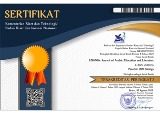The Effectiveness of Mufradat Cards in Arabic Learning Outcomes in Thematic Learning in Madrasah Ibtidaiyah
Abstract
Keywords
Full Text:
PDFReferences
Abduh, M., Nugroho, & Siskandar. (2014). Evaluasi Pembelajaran Tematik Dilihat Dari Hasil Belajar Siswa. IJCETS: Indonesian Journal of Curriculum and and Educational Technology Studies, 1(1), 1–9.
Albantani, A. M. (2018). Pembelajaran Bahasa Arab Di Madrasah Ibtidaiyyah: Sebuah Ide Terobosan. Attadib: Journal of Elementary Education, 2(2), 160–173. https://doi.org/10.32507/attadib.v2i2.417
Arip, M., Rapidah, B. A. B., Ahmad, A. B., & Jais, S. M. (2013). The development of a group guidance module for student self- development based on gestalt theory. Procedia - Social and Behavioral Sciences, 84, 1310–1316. https://doi.org/10.1016/j.sbspro.2013.06.748
Ariyanti, H., & Syarifah, S. (2021). Strategi Pembelajaran Bahasa Arab Dalam Meningkatkan Minat Belajar Bahasa Arab Siswa Kelas Vii Mts Nurul Muttaqin Simpang Tiga. Al-Mu’Arrib: Journal of Arabic Education, 1(1), 45–55. https://doi.org/10.32923/al-muarrib.v1i1.2080
Barus, Y. K., & Djukri, D. (2013). Pengembangan Buku Teks Tematik Tema Permainan Untuk Kelas III SDN Triadi Sleman Yogyakarta. Jurnal Prima Edukasia, 1(2), 208–221. https://doi.org/10.21831/jpe.v1i2.2638
Chen, Y. T. (2012). The effect of thematic video-based instruction on learning and motivation in e-learning. International Journal of the Physical Sciences, 7(6), 957–965. https://doi.org/10.5897/ijps11.1788
DEPDIKNAS. (2006). Model Pembelajaran Tematik. Jakarta: Puskur Balitbang.
Fogarty, R. (1991). Ten Ways to Integrate Curriculum. Educational Leadership, 49(2), 61–65.
Forti, B. (2015). What Are The Limits Of Gestalt Theory? American Psychological Association, 37(2), 161–188.
Hamruni, H., & Istiningsih, dan. (2017). The Analysis Of Material Presentation And Assessment Of Thematic Learning At State 1 Primary School Sleman Yogyakarta. IOSR Journal of Humanities and Social Science, 22(05), 23–37. https://doi.org/10.9790/0837-2205092337
Hidayati, T. N. (2011). Implementasi Teori Belajar Gestalt pada Proses Pembelajaran. Falasifa, (2(1)), 1–19.
Humphreys, A. H., Post, T. R., & Ellis, A. K. (1981). Interdisciplinary Methods: A Thematic Approach. California: Goodyear Publishing company.
Ismail, F. (2018). Statistika untuk Penelitian Pendidikan dan Ilmu-Ilmu Sosial. Jakarta: Prenadamedia Group.
Jumriana, dkk. (2019). Penerapan Media Kartu Bergambar Dalam Penguasaan Kosakata (Mufradât) Bahasa Arab Kelas Vii Mts. Bhayangkara Makassar. Jurnal Fakultas Bahasa Dan Sastra, 1(2), 1–12.
Khalilullah, M. (2011). Strategi Pembelajaran Bahasa Arab Aktif (Kemahiran Istima’ Dan Takallum). Jurnal Sosial Budaya, 8(2), 219–235.
Khansa, H. Q. (2016). Strategi Pembelajaran Bahasa Arab Hasna Qonita Khansa. Prosiding Konferensi Nasional Bahasa Arab II, 53–62.
Latifah, N. (2022). Penggunaan Media Kartu Dengan Model Pembelajaran Kooperatif Untuk Meningkatkan Penguasaan Kosakata Bahasa Arab di MIN 15 Hulu Sungai Selatan. Prosiding Pendidikan Profesi Guru Agama Islam (PPGAI), 2(1), 2174–2189.
Lawson, R., Chang, F., & Wills, A. J. (2017). Free classification of large sets of everyday objects is more thematic than taxonomic. Acta Psychologica, 172, 26–40. https://doi.org/10.1016/j.actpsy.2016.11.001
Min, K. C., Rashid, A. M., & Nazri, M. I. (2012). Teachers’ understanding and practice towards thematic approach in teaching integrated living skills (ILS) in Malaysia. International Journal of Humanities and Social Science, 2(23), 273–281.
Moleong, L. J. (2008). Metode Penelitian Kualitatif. Bandung: Remaja Rosdakarya.
Mustofa, B., & Hamid, A. (2012). Metode & Strategi Pembelajaran Bahasa Arab . Malang: UIN-Maliki Press. 2012.
Norilah, Madani, F. A. Z. M. H., & Noo, F. (2022). Strategi Pembelajaran Bahasa Arab Pada Tingkat Dasar Di Paud Istiqlal Banjarmasin. An-Nahdhah, 15(1), 38–56.
Novinsah, A. (2020). Strategi Pembelajaran Bahasa Arab di MI. EL-HIKMAH: Jurnal Kajian Dan Penelitian Pendidikan Islam, 14(2), 187–204. https://doi.org/10.20414/elhikmah.v14i2.2571
Okoro, C. O., & Okoro, C. U. (2016). Teachers’ Understanding and Use of Thematic Approach in Teaching and Learning of Social Studies in Rivers State. International Journal of Education, Learning and Development, 4(3), 64–69.
Prastowo, A. (2014). Kebutuhan Psikologis dengan Tematik. Jurnal Pendidikan Sekolah Dasar, 1, 1–13.
Rafikoh, Rahayu, T., & Hidayah, T. (2014). Pengembangan Materi Pembelajaran Penjarsorkes Tematik Untuk Kelas 1 Sekolah Dasar di Kabupaten Purworejo. Journal of Physical Education and Sport, 3(2), 61–66. https://doi.org/10.15294/jpes.v3i2.4801
Ramadhan, S., Sunan, U., & Yogyakarta, K. (2017). Strategi Pembelajaran Bahasa Arab Pada Anak Usia Dini. Utile: Jurnal Kependidikan, III(2), 180–189.
Ramosaj, D. S. B., & Berisha, Ms. G. (2014). Systems Theory and Systems Approach to Leadership. ILIRIA International Review, 4(1), 59. https://doi.org/10.21113/iir.v4i1.53
Riwanda, A., Ridha, M., & Islamy, M. I. (2021). Increasing Arabic Vocabulary Mastery Through Gamification; is Kahoot! Effective? LISANIA: Journal of Arabic Education and Literature, 5(1), 19–35. https://doi.org/10.18326/lisania.v5i1.19-35
Suharsimi, A. (2010). Prosedur penelitian suatu pendekatan praktik. Jakarta: Rineka Cipta, p. 172.
Suwardi, & Habibi, B. Y. (2022). Specifications for Textbook Materials at Madrasah Ibtidaiyah. 14(1), 86–101.
Wilujeng, E. R. (2013). Penerapan Pendekatan Ctl (Contextual Teaching and Learning) Dalam Pembelajaran Tematik Tema Lingkungan Untuk Meningkatkan Hasil Belajar Siswa Kelas Ii Sdn Klampis Ngasem Iv No. 560 Surabaya. Jurnal Penelitian Pendidikan Guru Sekolah Dasar, 1(1), 1–9.
Zahratun, F. (2015). Peningkatan Penguasaan Kosakata Bahasa Arab (Mufradat) Melalui Penggunaan Media Kartu Kata Bergambar. Jurnal Pendidikan Usia DINI, 9, 107–126.
Zulvira, R., Neviyarni, & Irdamurni. (2021). Karakteristik Siswa Kelas Rendah Sekolah Dasar. Jurnal Pendidikan Tambusai, 5(1), 1846–1851.
Zuraidah, Z., Humayro, A. H., & Khoiriyah, Z. (2022). Pengenalan Bahasa Arab Menggunakan Media Kartu Mufrodat Bergambar Di Tpq Al-Faqih. Jurnal Pengabdian Al-Ikhlas, 8(2), 1–7. https://doi.org/10.31602/jpaiuniska.v8i2.7946
DOI: https://doi.org/10.18326/lisania.v7i1.14-30
Refbacks
- There are currently no refbacks.
Copyright (c) 2023 Suwardi Imam

This work is licensed under a Creative Commons Attribution-ShareAlike 4.0 International License.
View My Stats







